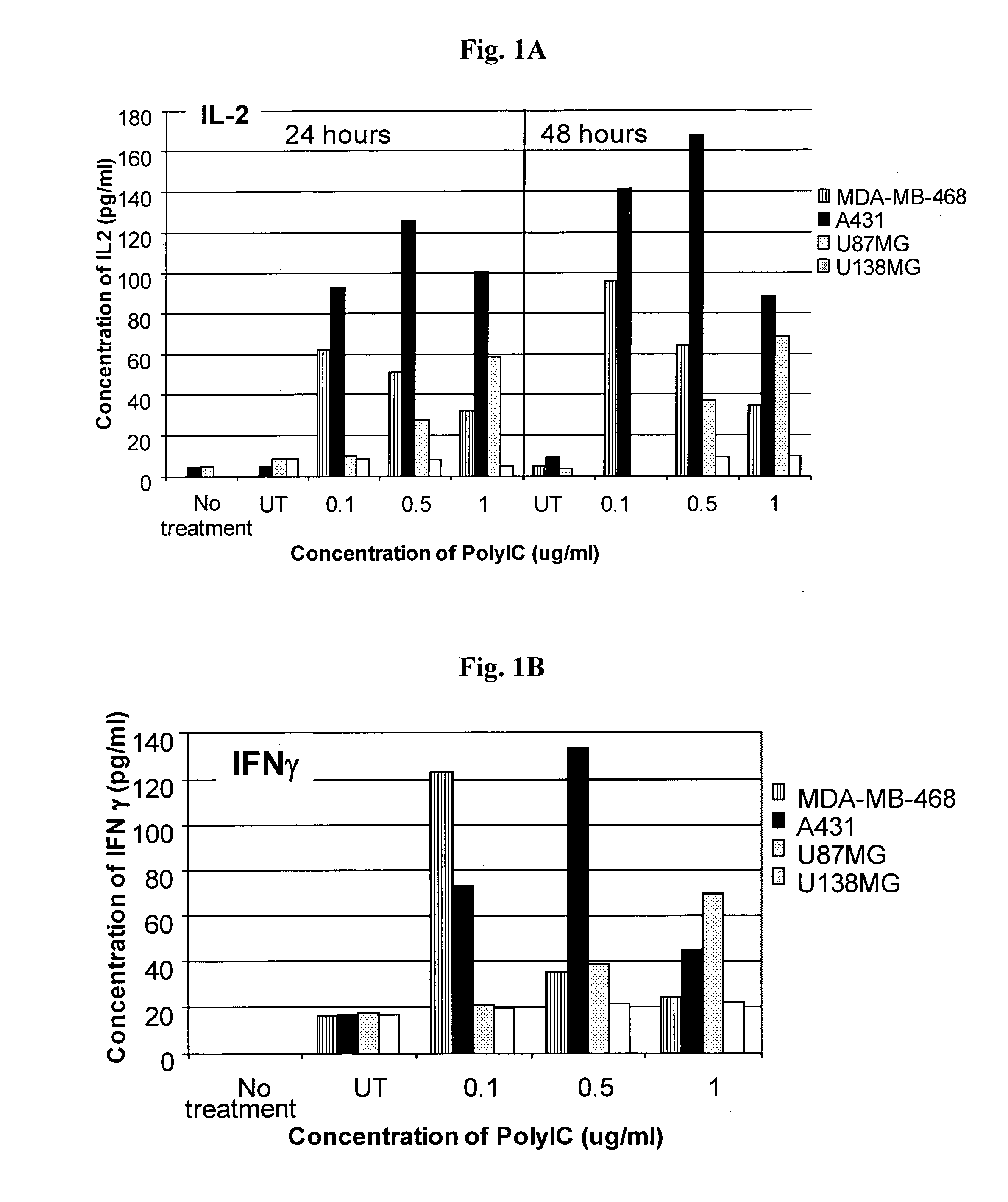Egfr-homing double-stranded RNA vector for systemic cancer treatment
a systemic cancer and rna technology, applied in the field of cancer therapy, can solve the problems of not actually treating patients, limited treatment to localized tumors, and virtually impossible to treat by conventional methods
- Summary
- Abstract
- Description
- Claims
- Application Information
AI Technical Summary
Benefits of technology
Problems solved by technology
Method used
Image
Examples
example 1
PolyIC / MPPE Induces Expression of Immunoactive Cytokines in A431 and MDA-MB-468 Cells
[0087]In our previous study (2) we showed that a low dose of EGFR-targeted PolyIC induced expression of IFN-α, IP-10 and Gro-α in EGFR overexpressing glioblastoma cells (U87MGwtEGFR), but not in cells with low levels of EGFR (U87MG). These data support the notion that cells produce these cytokines only when a certain threshold level of dsRNA has been internalized, and that this dose is achieved only in cells overexpressing EGFR. In this study we extended the analysis to two additional EGFR overexpressing cancer cell lines: A431 (vulval carcinoma) and MDA-MB-468 (breast carcinoma). When these cells were transfected with PolyIC / MPPE (2.5 μg / ml), we detected up to 5.1 pg / ml of IFN-13; 148 pg / ml of Gro-α and 188 pg / ml of IP-10 (Table 2). Gro-α and IP-10 are chemokines responsible for the recruitment of T cells to the area where they are expressed. Thus, A431 and MDA-MB-468 cells, like U87MGwtEGFR cells,...
example 2
In Vitro Activation of Human Immune Cells
[0088]Given the above results, we hypothesized that the cytokine-enriched medium from A431 and MDA-MB-468 cells treated with PolyIC / MPPE should stimulate the immune system. We examined whether this was so, by testing the effect of medium from PolyIC-transfected cancer cells on healthy human peripheral blood mononuclear cells (PBMCs). PBMCs consist of several types of immune cells (NK, T-cells, NK-T cells, macrophages). When activated, these cells produce toxic cytokines, such as IFN-γ and TNF-α, known to be effective against various cancer cells. PBMCs also interact with each other, leading to a synergistic, highly anti-proliferative effect. For example, activated T cells and NK cells produce IFN-γ, which activates macrophages and stimulates the production of TNF-α. Release of IL-2 into the medium correlates directly with PBMC activation and can be conveniently quantified by ELISA. Thus PBMCs are a convenient system for studying the selective...
example 3
Activation of PBMCs In Vivo
[0090]Expression of these cytokines selectively in EGFR overexpressing tumors was also confirmed in vivo (Table 3). SCID-NOD mice bearing EFGR overexpressing subcutaneous tumors on the right flank and U138MG tumors on the left flank were intravenously treated with 4 consecutive daily injections of PolyIC?MPPE followed by a single intraperitoneal injection of four million PMBCs. Expression of and, at much higher concentrations, in the EGFR overexpressing tumors (Table 3). These cytokines were expected to attract PMBCs selectively to the EGFR overexpressing tumors, where the PMBCs would be activated.
TABLE 3In vivo cytokine expression patternMDA-MB-468IP10Gro-αIFIL2IFNγTNFαPolyIC / −+−+−+−+−+−+MPPE / PBMCMDA-MB-0218201 44204015102400.89468U138MG04632236000033 0000Blood128145225000520200Blood 3 days11895220300——————A431IP10Gro-αIFNβIL2IFNγTNFαPolyIC / −+−+−+−+−+−+MPPE / PBMCA413163464118700 12011203800.74U138MG066240410000180000Blood229963263000 370600.12Blood 3 days3...
PUM
| Property | Measurement | Unit |
|---|---|---|
| Volume | aaaaa | aaaaa |
| Volume | aaaaa | aaaaa |
| Volume | aaaaa | aaaaa |
Abstract
Description
Claims
Application Information
 Login to View More
Login to View More - R&D
- Intellectual Property
- Life Sciences
- Materials
- Tech Scout
- Unparalleled Data Quality
- Higher Quality Content
- 60% Fewer Hallucinations
Browse by: Latest US Patents, China's latest patents, Technical Efficacy Thesaurus, Application Domain, Technology Topic, Popular Technical Reports.
© 2025 PatSnap. All rights reserved.Legal|Privacy policy|Modern Slavery Act Transparency Statement|Sitemap|About US| Contact US: help@patsnap.com



